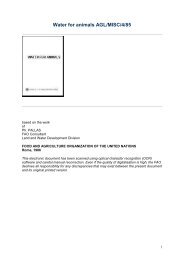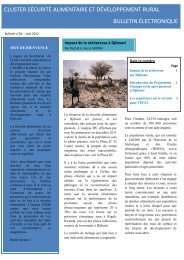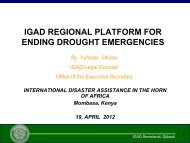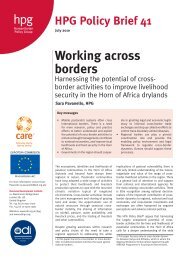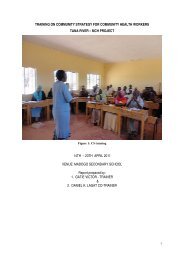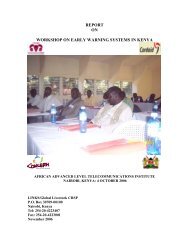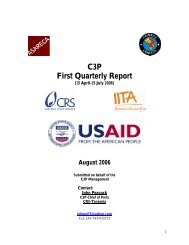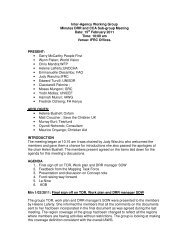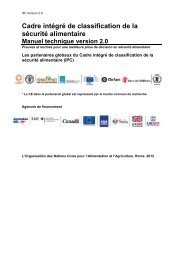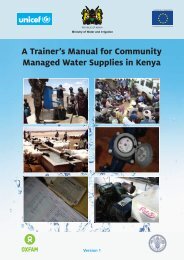Synthesis of Existing Knowledge and Experience on the Provision of ...
Synthesis of Existing Knowledge and Experience on the Provision of ...
Synthesis of Existing Knowledge and Experience on the Provision of ...
You also want an ePaper? Increase the reach of your titles
YUMPU automatically turns print PDFs into web optimized ePapers that Google loves.
to inform <strong>the</strong>ir own work <str<strong>on</strong>g>and</str<strong>on</strong>g> help <strong>the</strong>m implement higher quality water development interventi<strong>on</strong>sin pastoralist areas <str<strong>on</strong>g>and</str<strong>on</strong>g> with pastoralist communities in future.It is hoped that in additi<strong>on</strong> to facilitating learning am<strong>on</strong>gst <strong>the</strong> partners that <strong>the</strong> findings will alsoinform o<strong>the</strong>r actors engaged in water development in pastoral areas, <str<strong>on</strong>g>and</str<strong>on</strong>g> perhaps encourageincreased reflecti<strong>on</strong> <strong>on</strong> current approaches <str<strong>on</strong>g>and</str<strong>on</strong>g> practice leading to more appropriate, <str<strong>on</strong>g>and</str<strong>on</strong>g> it isbelieved ‘successful 7 ’, water development in pastoral areas.The research informing this overview was not restricted to a review <str<strong>on</strong>g>of</str<strong>on</strong>g> <strong>the</strong> partners own work, butalso mapped out <strong>the</strong> bigger picture <str<strong>on</strong>g>of</str<strong>on</strong>g> who is involved, where, how, whe<strong>the</strong>r <str<strong>on</strong>g>and</str<strong>on</strong>g> how approaches towater development have changed over <strong>the</strong> last few decades, <str<strong>on</strong>g>and</str<strong>on</strong>g> what some <str<strong>on</strong>g>of</str<strong>on</strong>g> <strong>the</strong> current majorinterventi<strong>on</strong>s are – all within <strong>the</strong> framework <str<strong>on</strong>g>of</str<strong>on</strong>g> nati<strong>on</strong>al <str<strong>on</strong>g>and</str<strong>on</strong>g> regi<strong>on</strong>al policies, plans, <str<strong>on</strong>g>and</str<strong>on</strong>g> strategies. Italso explores <strong>the</strong> level <str<strong>on</strong>g>of</str<strong>on</strong>g> coordinati<strong>on</strong> between different actors in <strong>the</strong> field, whe<strong>the</strong>r activities build<strong>on</strong> existing pastoral natural resource management know-how, <str<strong>on</strong>g>and</str<strong>on</strong>g> less<strong>on</strong>s learned from previouswater development interventi<strong>on</strong>s.Based <strong>on</strong> an extensive review <str<strong>on</strong>g>of</str<strong>on</strong>g> published <str<strong>on</strong>g>and</str<strong>on</strong>g> unpublished documents, <str<strong>on</strong>g>and</str<strong>on</strong>g> over fifty in-depthinterviews with development practiti<strong>on</strong>ers <str<strong>on</strong>g>and</str<strong>on</strong>g> representatives <str<strong>on</strong>g>of</str<strong>on</strong>g> government <str<strong>on</strong>g>and</str<strong>on</strong>g> d<strong>on</strong>or agenciesengaged in water development in pastoral regi<strong>on</strong>s, this report also highlights ‘good’ <str<strong>on</strong>g>and</str<strong>on</strong>g> poor’practice as identified by interviewees. For <strong>the</strong> purposes <str<strong>on</strong>g>of</str<strong>on</strong>g> this report, ‘good’ <str<strong>on</strong>g>and</str<strong>on</strong>g> ‘poor’ practice ispresented as: 1) approaches that are unanimously seen to work in <strong>the</strong> pastoral c<strong>on</strong>text, 2)approaches that are seen as problematic, 3) approaches which appear promising but where morefield level research <str<strong>on</strong>g>and</str<strong>on</strong>g> documentati<strong>on</strong> is likely to be necessary.1.3 Scope <str<strong>on</strong>g>and</str<strong>on</strong>g> structure <str<strong>on</strong>g>of</str<strong>on</strong>g> <strong>the</strong> reportThe partners specifically restricted <strong>the</strong> c<strong>on</strong>tent <str<strong>on</strong>g>of</str<strong>on</strong>g> this report to a discussi<strong>on</strong> <str<strong>on</strong>g>of</str<strong>on</strong>g> water developmentfor livestock use (<str<strong>on</strong>g>and</str<strong>on</strong>g> human use 8 ) in arid areas where livestock keeping is <strong>the</strong> dominant livelihood,<str<strong>on</strong>g>and</str<strong>on</strong>g> where agricultural producti<strong>on</strong> is limited due to insufficient <str<strong>on</strong>g>and</str<strong>on</strong>g> unreliable rainfall. Therefore <strong>the</strong>main thrust <str<strong>on</strong>g>of</str<strong>on</strong>g> this report is <strong>on</strong> water development for human <str<strong>on</strong>g>and</str<strong>on</strong>g> livestock use in regi<strong>on</strong>spredominantly inhabited by pastoralists (ra<strong>the</strong>r than agro-pastoralists or farmers). The areas coveredare those regi<strong>on</strong>s or areas where absolute rainfall is low. These areas generally occupy <strong>the</strong> lowl<str<strong>on</strong>g>and</str<strong>on</strong>g>areas <str<strong>on</strong>g>of</str<strong>on</strong>g> <strong>the</strong> country. Regi<strong>on</strong>s included in this review include Afar, Somali, <str<strong>on</strong>g>and</str<strong>on</strong>g> <strong>the</strong> arid z<strong>on</strong>es <str<strong>on</strong>g>of</str<strong>on</strong>g>Oromia <str<strong>on</strong>g>and</str<strong>on</strong>g> <strong>the</strong> Sou<strong>the</strong>rn Nati<strong>on</strong>s, Nati<strong>on</strong>alities <str<strong>on</strong>g>and</str<strong>on</strong>g> Peoples’ Regi<strong>on</strong> (SNNPR) (See Figures 1 <str<strong>on</strong>g>and</str<strong>on</strong>g> 2).It was not within <strong>the</strong> scope <str<strong>on</strong>g>of</str<strong>on</strong>g> this report to include informati<strong>on</strong> from o<strong>the</strong>r pastoralist areas such asparts <str<strong>on</strong>g>of</str<strong>on</strong>g> Gambella, Benishangul-Gumuz <str<strong>on</strong>g>and</str<strong>on</strong>g> Tigray.Figure 1: Rainfall distributi<strong>on</strong> <str<strong>on</strong>g>and</str<strong>on</strong>g> elevati<strong>on</strong> maps, Ethiopia.7 Meant here as developments which will address water shortages <str<strong>on</strong>g>and</str<strong>on</strong>g> meet <strong>the</strong> dem<str<strong>on</strong>g>and</str<strong>on</strong>g> for water withoutencouraging c<strong>on</strong>flict, <strong>the</strong> degradati<strong>on</strong> <str<strong>on</strong>g>of</str<strong>on</strong>g> <strong>the</strong> rangel<str<strong>on</strong>g>and</str<strong>on</strong>g>s <str<strong>on</strong>g>and</str<strong>on</strong>g> <strong>the</strong> weakening <str<strong>on</strong>g>of</str<strong>on</strong>g> rangel<str<strong>on</strong>g>and</str<strong>on</strong>g>-dependent livelihoods.8 Since water for human use is also generally water for livestock use in pastoral regi<strong>on</strong>s.18



